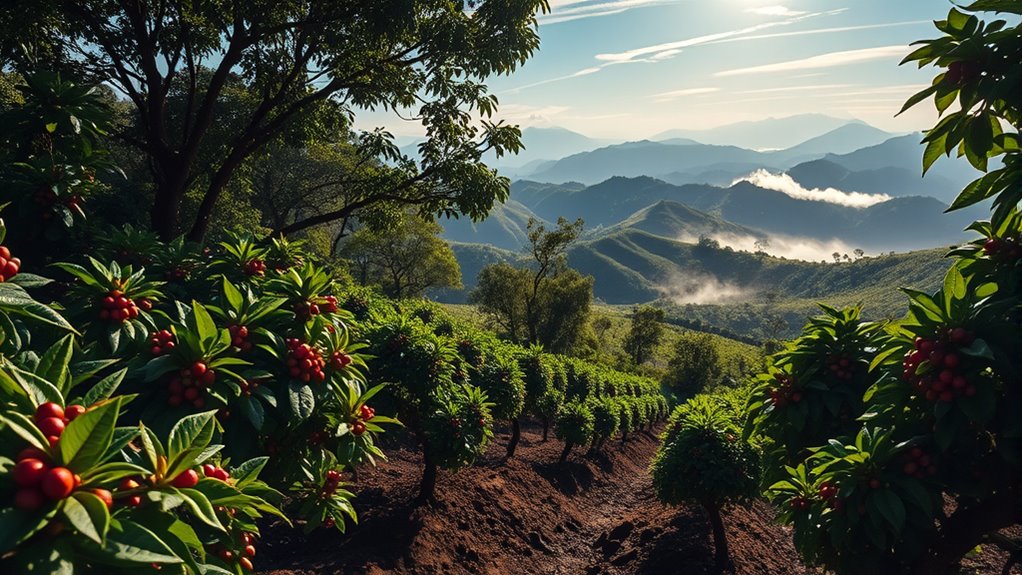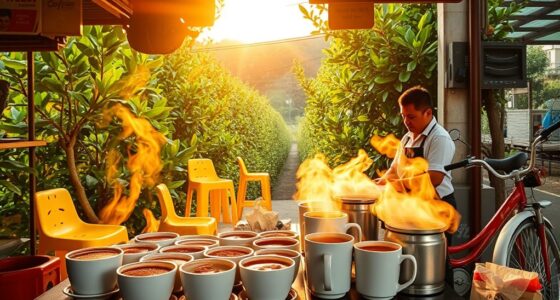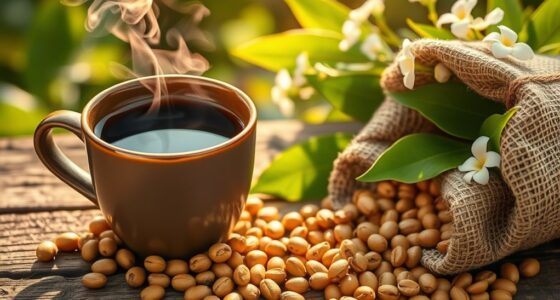In Santa Ana and Apaneca-Ilamatepec, you can explore high-quality Salvadoran coffee on guided tours hosted by passionate local farmers. You’ll see firsthand how microclimates and volcanic soils create unique flavors, learn about sustainable practices, and observe the harvesting and processing methods. These regions also offer demonstrations of brewing techniques like pour-over and French press, helping you appreciate the region’s vibrant coffee culture. Stay with us to uncover more about these exceptional coffee destinations.
Key Takeaways
- Santa Ana and Apaneca-Ilamatepec are renowned for high-quality, flavorful Salvadoran coffee grown in volcanic soils.
- Guided farm tours offer insights into sustainable practices, harvesting, processing, and traditional cultivation methods.
- Visitors can experience brewing demonstrations like pour-over and French press, emphasizing flavor nuances.
- Coffee in these regions features bright acidity, subtle fruitiness, and rich, complex profiles shaped by microclimates.
- The regions’ coffee culture reflects deep-rooted traditions and a commitment to organic, environmentally friendly farming.

El Salvador is renowned for its high-quality coffee, and if you’re a coffee enthusiast, exploring its unique brews is a must. The regions of Santa Ana and Apaneca-Ilamatepec stand out as perfect destinations to immerse yourself in the world of coffee. When you visit these areas, you’ll find that coffee farm tours are among the most enriching experiences. Guided by passionate local growers, you get a firsthand look at the entire coffee production process—from the lush, shaded plantations to the meticulous harvest of ripe cherries. These tours often include explanations about the specific microclimates and volcanic soil that give Salvadoran coffee its distinctive flavor. As you walk through the coffee fields, you’ll gain insights into sustainable farming practices and the importance of elevation in producing high-quality beans. Participating in these tours also allows visitors to see how sustainable resources are prioritized in coffee cultivation, highlighting the region’s commitment to environmentally friendly practices.
Once you’ve seen how coffee is cultivated, it’s time to explore the art of coffee brewing techniques. Many local farms and cafes offer demonstrations on how to brew the perfect cup, highlighting methods like pour-over, French press, and AeroPress. You’ll learn how water temperature, grind size, and brewing time influence the final taste. Trying your hand at these techniques allows you to appreciate the nuances of Salvadoran coffee, which often boasts bright acidity, balanced body, and a subtle fruitiness. These experiences give you the knowledge to recreate the flavors at home and deepen your appreciation for the craft behind each sip.
In Santa Ana and Apaneca-Ilamatepec, coffee is more than just a beverage—it’s a cultural cornerstone. As you tour the farms, you’ll notice the dedication and passion of local farmers who have inherited traditions from generations past. Many farms emphasize organic and sustainable practices, ensuring that the coffee you taste maintains its authenticity and quality. During your visits, don’t hesitate to ask questions about the harvesting process, processing methods, and the specific roast profiles that best showcase the beans’ unique characteristics. This interaction enriches your understanding and helps you develop a more refined palate.
Frequently Asked Questions
What Are the Best Times of Year to Visit Coffee Farms?
The best visiting seasons for coffee farms are during the dry months of November to April, when the weather is clear and harvesting is in full swing. These are the ideal travel months to enjoy the lush landscapes and coffee tours without rain interruptions. You’ll get the best experience and views during this time, making it perfect for exploring and learning about coffee cultivation firsthand.
Are There Eco-Friendly Coffee Tours Available in Santa Ana?
You’ll find eco-friendly coffee tours in Santa Ana that truly hit the sweet spot. These tours showcase sustainable farming practices and eco-tourism initiatives, giving you a chance to learn about coffee cultivation while protecting the environment. Many farms welcome visitors interested in responsible tourism, allowing you to enjoy coffee tasting and farm walks without leaving a heavy footprint. It’s a win-win for the planet and your adventure!
How Do Local Traditions Influence Coffee Harvesting Methods?
Local customs greatly influence your coffee harvesting techniques. You’ll notice that traditional methods are rooted in community practices and respect for the land. For instance, handpicking beans aligns with local customs, ensuring quality and sustainability. These traditions shape how farmers harvest, often involving family teamwork and rituals passed down generations. By following these local customs, you help preserve cultural heritage while maintaining the authenticity and quality of the coffee.
Can Travelers Participate in Coffee Picking Experiences?
Yes, you can participate in coffee harvesting and farm participation experiences. Many coffee farms welcome travelers to join in the coffee picking, allowing you to learn about local traditions firsthand. By engaging in coffee harvesting, you get a deeper appreciation for the process and the effort behind each cup. Just check with the farm beforehand to guarantee they’re offering participation opportunities, and be ready to help during the busy harvest season.
What Are the Health Benefits of El Salvador’s Coffee?
You benefit from El Salvador’s coffee health benefits by enjoying its antioxidants, which help combat free radicals and boost your immune system. The coffee processing methods preserve these antioxidants, supporting mental alertness and reducing risk factors for certain diseases. Drinking moderate amounts can improve your mood, enhance physical performance, and provide a natural energy boost. So, savoring this coffee not only delights your senses but also contributes positively to your overall health.
Conclusion
As you explore El Salvador’s coffee regions like Santa Ana and Apaneca-Ilamatepec, you’ll discover a brew as rich and vibrant as the volcanic landscapes themselves. Think of these coffee farms as hidden gems waiting to awaken your senses, transforming every sip into a flavorful journey. So, go ahead—dive into this aromatic adventure and let the coffee’s warmth and depth leave a lasting impression, like a cherished memory etched in every cup.








